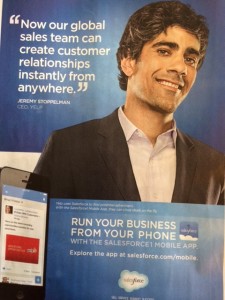Seduced by Tools and Processes
 One of my favorite newsletters comes on Sunday mornings from Andy Paul. It’s called The Weekly Sales Fix. (He also does a great weekly podcast). While he focuses mostly on large B2B sellers, his thoughts this week mirror what I’ve also been seeing in smaller B2C marketers.
One of my favorite newsletters comes on Sunday mornings from Andy Paul. It’s called The Weekly Sales Fix. (He also does a great weekly podcast). While he focuses mostly on large B2B sellers, his thoughts this week mirror what I’ve also been seeing in smaller B2C marketers.
The overall thought is an over-reliance on tools and processes.
First, Andy’s take on it:
I’ve been in sales for 4 decades….
We’ve all read about the various research findings that paint a dismal picture of the state of B2B sales.
Low quota attainment rates. Falling close rates. Increased ‘No Decision’ rates. Buyers saying they find no value in their interactions with sales reps.
However, I believe that the fundamental reason these problems exist is that we have taken our eyes off the ball.
Too many in sales are trying to substitute process, methodology and technology for the fundamental and irreplaceable human connections that are at the heart of the B2B sales transaction.
The true science of selling is not about metrics. It’s about the science of mastering the human to human interaction.
Unfortunately, sales people today aren’t being sufficiently educated about the human element of sales.
The more time I spend in sales, and the more time I invest in working to help other sales people, the more clearly I’ve come to see that the keys to success at any level in our profession are directly tied to mastering a small handful of basic human behaviors.
Be human.
Ask great questions.
Listen slowly.
Deliver value.
You can make it more complicated than this. But, why would you?
Because, no matter what sales process, technology or methodology you utilize, your ability to win ultimately boils down to mastering those four behaviors to build functional and effective relationships with your buyers.
Simplicity.
Well said, Andy. Now let me apply those same thoughts to what I’ve been seeing on the smaller business side.
I get (and I bet many of you do too) a lot of emails and LinkedIn requests that completely ignore Andy’s advice.
- Someone sends me a LinkedIn request; they look interesting, so I accept. Within hours, I get a message telling me about their services and suggesting a call or a meeting.
- Someone sends me an email – it says a bit about their services, but absolutely nothing about me or my business, much less why I might be interested. Worse, they assert that they’re relevant and can help me. Worse still, they suggest a call or a meeting to explore how they can help me.
The Seductiveness of Tools and Processes
On the B2B side, the sheer power and connectedness of today’s CRM-and-related systems is impressive. As with all tech, things are getting digitized and interconnected. You can track and link to virtually unlimited amounts of things, including your own (automated) ‘content’ and customers’ responses.
The seduction is this: the belief that Because You Can, Therefore You Should.
- On the B2B side, because you can micro-identify potential buyers, their past behaviors, their likely interests, and monitor their reactions to anything you might put out, therefore you should do all the above.
No, you shouldn’t. Because as Andy Paul points out, the approach touches precisely zero of the four factors Andy calls “keys to success.”
- On the smaller business side, the seduction is that because you can easily invite me to join you on LinkedIn or ID me on a targeted mailing list and send me the equivalent of your brochure at zero cost, therefore you should do all the above.
No, you shouldn’t. Because if your response to an invitation acceptance is to send me a pitch, you’re committing the business equivalent of asking for sex on the first date. It’s just not done. It’s rude.
Worse, it pretty much doesn’t even work. The law of large numbers won’t help you. If your strategy was to micro-target desirable buyers with all your great screening tools, then offensiveness actually backfires on you: not only is the potential market smaller, but your bad reputation spreads more thoroughly.
Whether you’ve been seduced by processes or by tools, you are
a. Not being human
b. Not asking great (any?) questions
c. Not listening slowly (if at all)
d. Not delivering value
With great tech comes great temptation: Just because you can do something doesn’t mean you should. As Andy says, keep it simple, and keep it human.

 “Now our global sales team can create customer relationships instantly from anywhere.”
“Now our global sales team can create customer relationships instantly from anywhere.”